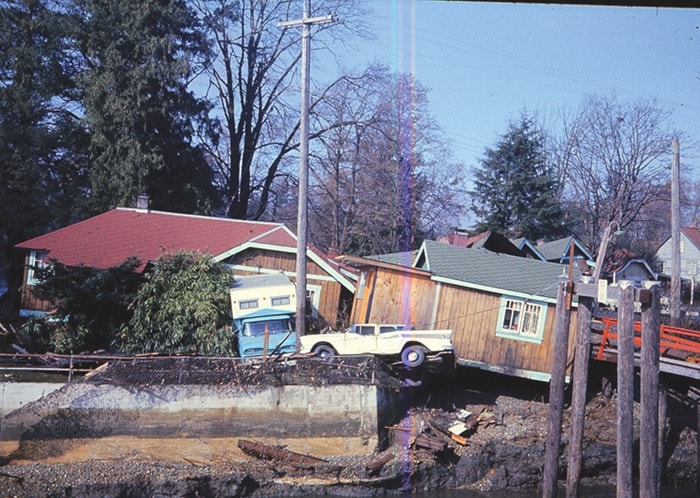For residents and workers in the low-lying areas of the twin cities of Alberni and Port Alberni, the Good Friday 1964 Tsunami began quietly with logs piling up in the Somass Estuary.
Alberni city manager Jim Sawyer was at home when he received a phone call late in the evening from work superintendent Bob Waugh.
“He said he’d been called in to clear up some of the debris that was flooding up onto River Road. He didn’t know what it was, but we thought it might be a tidal wave,” Sawyer said.
With a potential emergency situation developing, he went to Alberni City Hall, at the foot of Johnston Road, and lit up the city’s two-way radio system.
Simon and Yvette Gaetz lived close by on Margaret Street, virtually on the banks of the Somass. At the time, Yvette was nine months pregnant with her son, Wayne.
“My sister had been visiting, and she was just leaving at around midnight, and the water came up to the first step,” Yvette said.
When Simon saw the initial flooding, he realized it was somehow connected to the Anchorage quake.
“I was just coming home from work. I was on maintenance at Somass [Division], and I got off at 12,” Simon said.
“He came home and said, ‘There’s a tidal wave,’” Yvette said. “But we didn’t know what a tidal wave was.”
George Smith was working on the second floor of the nearby paper mill. He and his coworkers had noticed logs floating upriver earlier, but hadn’t been alarmed to that point. That all changed when the second surge struck at about 1 a.m.
“I was in the washroom and tried to flush the toilet. That was just when the waterline broke,” he said.
A mass of logs and debris had ripped out the Sproat Lake waterline and tore out the walls of the Port Alberni sewage lagoons just across the river, releasing a mass of sewage into the floodwaters.
“I ran out of the washroom and the whole place was in a panic. At the time, the mill had seven boilers: four generators and three recovery boilers, and they all got their water from that waterline. They had to do an emergency shutdown.”
At city hall, Sawyer heard the rush of water and went outside to look.
“I just stepped out the front door when I heard all the boilers shutting down. Then everything went dark.”
After the shrieking of the boilers died down, the only sound was of logs crashing together in the darkness.
At the same time, Yvette found herself waist-deep in sludge, with her three children floating on a mattress. Simon and Yvette’s younger brother were unable to open the front door, so the only escape was up. They popped the ceiling hatch into the attic and lifted first the children, then the very-pregnant Yvette to safety.
“We just stayed up there and prayed that the house wouldn’t get swept away,” Yvette said.
At the paper mill, the employees were not allowed to leave until daylight. They stumbled into an apocalyptic landscape of broken buildings, logs, lumber and especially, crushed and upended automobiles.
Jan Jansma, who had also been working at Somass Division, captured many of those enduring images, in living colour. When the first major surge knocked out the power, he and his co-workers on the No. 5 drop-sort simply went home. Had they remained 20 minutes longer, they likely would have been swept to their deaths in the second surge.
“I was at home in Beaver Creek, listening to the radio reports [on CJAV], when the station went off the air. The next morning, I turned on CKNW in Vancouver and found out what had happened.”
Knowing there had been major damage all over the Valley, Jansma grabbed his camera and four rolls of Ektachrome colour slide film. Over the next two days, he captured a series of images that have become synonymous with the Good Friday Tsunami: the house that appears to have pulled up to the gas pumps at the Beaver Creek and River Road B/A station; the demolished Auto Court; stacks of lumber strewn like toothpicks in the Somass Division yard; thousands of loose logs floating in the harbour, seen from above the Plywood mill.
The slide film had to be mailed out to Kodak for processing, so it took a few days before anybody got a look at them. But in the 50 years since the tsunami, they have become the most-recognizable images of the disaster.
Jansma doesn’t know how many news organizations used his pictures and he never received a dime for his work, but says he has no regrets.
“That’s history,” he shrugged. “I eventually gave the whole works to the [Alberni Valley] Museum, and told them ‘You can do what you want with them.’ They put them all on a disk.”
What does bother him is when they run without a photo credit, which sometimes happens, he added.
Smith said there were so many cars damaged in the flooding, many owners took unusual measures to get them running again, such as dunking them in Sproat Lake to rinse out the salt water.
“There was a stigma for a number of years about buying a car from Port Alberni. I got mine running, but two weeks later, it blew up,” Smith said.
It was also two weeks later that Yvette and Simon’s son Wayne was born. Even after an extensive cleanup, it took two years to sell the Margaret Street home. The couple moved to higher elevation on Grandview Road, where they lived for 22 years.
“We were going to go far enough that the water wasn’t going to get us.”
